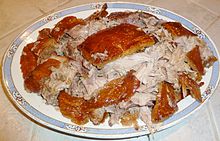
Crispiness or crispness is one of the most common food texture attributes. Crispiness refers to a hard food that emits a sound upon fracturing. Foods described as crisp tend not to show signs of deformation prior to fracture. Crispiness and crunchiness are often used interchangeably, however crispiness tends to be associated with a higher pitched sound, while crunchiness is associated with lower pitched sounds; however, this type of level of heating in cooking generally has a soft tender inside left after heating.
Cooking techniques for crispiness
There are a number of techniques to achieve crispiness when cooking. Frying food can make it crispy, such as seen in french fries. A breading coating using flour, egg wash, and bread crumbs will provide a layer of crispiness. Baking and roasting impart crispiness, as well, as noted in the skin of Peking duck, porchetta or pernil.
Crispiness is lost when food items are heated in the microwave oven as microwaves heat water within the food that then makes the food margins soggy.
References
- Luckett, Curtis; Seo, Han-Seok (2015). "Consumer Attitudes Toward Texture and Other Food Attributes". Journal of Texture Studies. 46 (1): 46–57. doi:10.1111/jtxs.12110.
- Jowitt, Ronald (1974). "The terminology of food texture". Journal of Texture Studies. 5 (3): 351–358. doi:10.1111/j.1745-4603.1974.tb01441.x.
- Editors, America's Test Kitchen (2012). The Science of Good Cooking. America's Test Kitchen, 2012. p. 152f. ISBN 978-1-933615-98-1.
{{cite book}}:|author=has generic name (help)